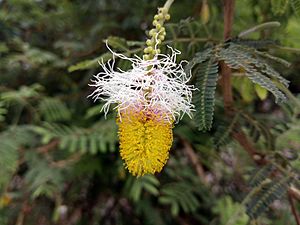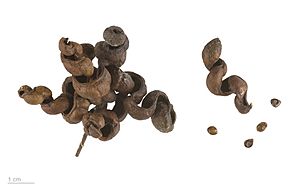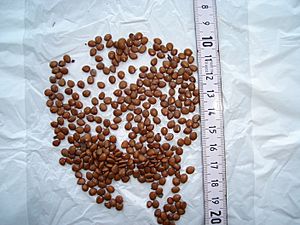Dichrostachys cinerea facts for kids
Quick facts for kids Sicklebush |
|
|---|---|
 |
|
| Conservation status | |
| Scientific classification | |
| Kingdom: | |
| (unranked): | |
| (unranked): | |
| (unranked): | |
| Order: | |
| Family: | |
| Genus: |
Dichrostachys
|
| Species: |
D. cinerea
|
| Binomial name | |
| Dichrostachys cinerea Wight et Arn.
|
|
| Synonyms | |
The Sicklebush (Dichrostachys cinerea) is a cool plant from the legume family, just like peas and beans! It's also known by fun names like Bell mimosa, Chinese lantern tree, or even Kalahari Christmas tree in South Africa. People in different places call it other names too, like el marabú in Cuba or kéké in Réunion.
Contents
What's in a Name?
The name Dichrostachys sounds fancy, right? It actually means 'two-colored spike'. This is because its flowers grow in spikes that have two different colors! The word comes from ancient Greek words meaning 'twice', 'color', and 'ear of grain'.
The second part of its name, cinerea, means 'ashes' in Latin. This refers to the grayish, ash-like hairs found on some types of the plant.
Where Does it Grow?
The Sicklebush naturally grows in Africa, the Indian subcontinent, and northern Australia. It has also been brought to the Caribbean and parts of Southeast Asia. You can find it in places like Nechisar National Park in Ethiopia.
An Invasive Plant
This tree arrived in the Caribbean in the 1800s. In Cuba, it's called "El Marabú" or "Marabou weed". It has become a big problem there, taking over about 20,000 square kilometers (about 7,700 square miles) of farmland!
However, people are now looking for ways to use it. They plan to turn it into biomass to create clean energy. The Sicklebush is also starting to appear in Florida, USA. Scientists are still figuring out if humans or birds brought it there.
What Does it Look Like?
Sicklebush trees usually grow up to 7 meters (about 23 feet) tall. They have strong, sharp thorns that can be up to 8 centimeters (about 3 inches) long. Their leaves are made up of many small leaflets and can be up to 15 centimeters (about 6 inches) long.
Unique Flowers and Pods
The flowers of the Sicklebush are really special. They grow in two-colored, cylinder-shaped spikes that look a bit like Chinese lanterns. These spikes are about 6 to 8 centimeters (2.4 to 3.1 inches) long and smell nice. The upper flowers on a hanging spike are usually sterile (meaning they don't produce seeds) and are a pretty lilac or pale purple color.
The seed pods are usually a mustard brown color and are often twisted or spiraled. They can be quite long, up to 100 millimeters (about 4 inches).
There are two slightly different types of Sicklebush: D. cinerea ssp. africana and D. cinerea ssp. nyassana. The nyassana type is usually bigger and has less hair on its leaves.
Where it Lives and Grows
This plant often grows in areas with clear rainforest zones, even at high altitudes up to 2,000 meters (about 6,500 feet). It likes places with strong seasonal weather, where the temperature changes a lot. It can grow in brushwood, thickets, hedges, teak forests, and grasslands. It's not picky about soil and can grow in poorer quality clay soils or deep, sandy soils.
In India, you might find it in dry deciduous forests.
In southern Africa, the Sicklebush usually flowers from October to February. Its fruits appear from May to September. The tree grows at a medium to slow pace, about 6 to 8 centimeters (2.4 to 3.1 inches) per year.
How is it Used?
The fruits and seeds of the Sicklebush are safe to eat. Many animals, like giraffes, buffaloes, kudus, and hartebeests, love to eat the juicy pods that fall to the ground. These animals also munch on the young twigs and leaves, which are rich in protein and minerals.
Other Uses
- Honey Source: The flowers can be a great source of honey for bees.
- Wood: The wood is very dense and burns slowly without being toxic, so it's often used for fuelwood. It's a strong, long-lasting hardwood. People in central Africa often use it to make smaller items like walking sticks, tool handles, and spears.
- Traditional Medicine: In some traditional practices, different parts of the plant are used. For example, the bark might be used for headaches or toothaches. Root mixtures are sometimes used for coughs or as a diuretic (which helps the body get rid of extra water). Leaves might be used as a laxative.
- Soil Helper: Because it's rich in nutrients, the Sicklebush is often used as a fertilizer, especially along riverbanks in Africa. It's also widely used to help protect soil from erosion, particularly in India, in shallow or sandy soils.
- Bonsai: Some people even grow the Sicklebush indoors as a bonsai tree, which is a miniature tree grown in a pot.
Despite all its uses, the Sicklebush is still seen as a threat to farming in many places. It's even listed on the Global Invasive Species Database because it can spread so quickly and take over land.
- Dichrostachys cinerea in West African plants – A Photo Guide.
See also
 In Spanish: Marabú o aroma para niños
In Spanish: Marabú o aroma para niños







